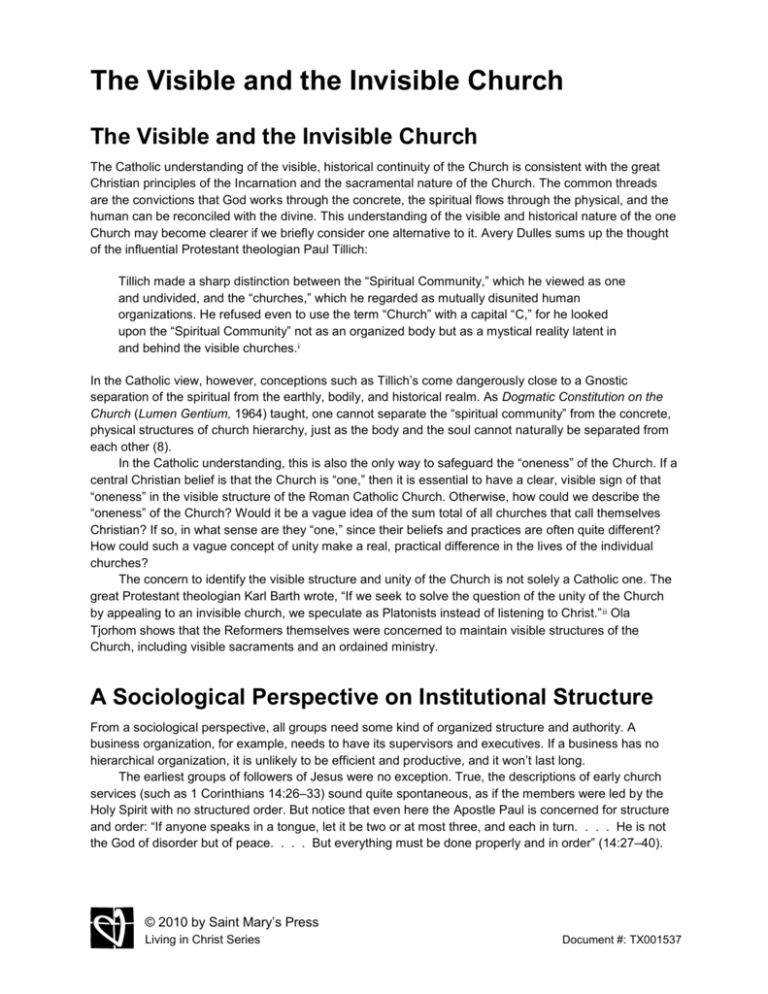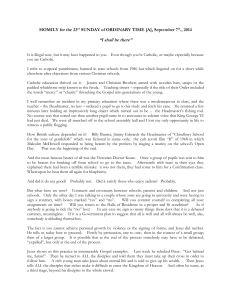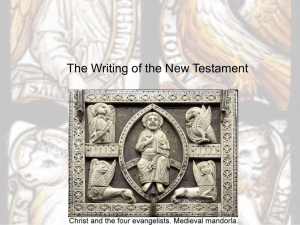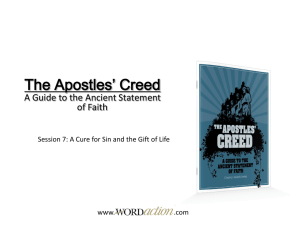
The Visible and the Invisible Church
The Visible and the Invisible Church
The Catholic understanding of the visible, historical continuity of the Church is consistent with the great
Christian principles of the Incarnation and the sacramental nature of the Church. The common threads
are the convictions that God works through the concrete, the spiritual flows through the physical, and the
human can be reconciled with the divine. This understanding of the visible and historical nature of the one
Church may become clearer if we briefly consider one alternative to it. Avery Dulles sums up the thought
of the influential Protestant theologian Paul Tillich:
Tillich made a sharp distinction between the “Spiritual Community,” which he viewed as one
and undivided, and the “churches,” which he regarded as mutually disunited human
organizations. He refused even to use the term “Church” with a capital “C,” for he looked
upon the “Spiritual Community” not as an organized body but as a mystical reality latent in
and behind the visible churches.i
In the Catholic view, however, conceptions such as Tillich’s come dangerously close to a Gnostic
separation of the spiritual from the earthly, bodily, and historical realm. As Dogmatic Constitution on the
Church (Lumen Gentium, 1964) taught, one cannot separate the “spiritual community” from the concrete,
physical structures of church hierarchy, just as the body and the soul cannot naturally be separated from
each other (8).
In the Catholic understanding, this is also the only way to safeguard the “oneness” of the Church. If a
central Christian belief is that the Church is “one,” then it is essential to have a clear, visible sign of that
“oneness” in the visible structure of the Roman Catholic Church. Otherwise, how could we describe the
“oneness” of the Church? Would it be a vague idea of the sum total of all churches that call themselves
Christian? If so, in what sense are they “one,” since their beliefs and practices are often quite different?
How could such a vague concept of unity make a real, practical difference in the lives of the individual
churches?
The concern to identify the visible structure and unity of the Church is not solely a Catholic one. The
great Protestant theologian Karl Barth wrote, “If we seek to solve the question of the unity of the Church
by appealing to an invisible church, we speculate as Platonists instead of listening to Christ.” ii Ola
Tjorhom shows that the Reformers themselves were concerned to maintain visible structures of the
Church, including visible sacraments and an ordained ministry.
A Sociological Perspective on Institutional Structure
From a sociological perspective, all groups need some kind of organized structure and authority. A
business organization, for example, needs to have its supervisors and executives. If a business has no
hierarchical organization, it is unlikely to be efficient and productive, and it won’t last long.
The earliest groups of followers of Jesus were no exception. True, the descriptions of early church
services (such as 1 Corinthians 14:26–33) sound quite spontaneous, as if the members were led by the
Holy Spirit with no structured order. But notice that even here the Apostle Paul is concerned for structure
and order: “If anyone speaks in a tongue, let it be two or at most three, and each in turn. . . . He is not
the God of disorder but of peace. . . . But everything must be done properly and in order” (14:27–40).
© 2010 by Saint Mary’s Press
Living in Christ Series
Document #: TX001537
The Visible and the Invisible Church
Page | 2
This same letter also refers to a hierarchical structure of authority: “Some people God has designated in
the church to be, first, apostles; second, prophets; third, teachers” (12:28).
If the followers of Jesus had not organized themselves into structured communities with a clear
leadership, Jesus’ teaching would have been forgotten and lost within a few generations. The whole
process of writing and canonizing the New Testament could only have been accomplished through
organized communities.
We now turn to a consideration of a particular group of the earliest Christian community leaders—the
Apostles, and the Catholic notion of Apostolic Succession.
Visible Structure of the Church and Apostolic
Succession
Apostolic Tradition and Apostolic Succession are closely related, since the reliability of the tradition (what
is taught) cannot be separated from the reliability of the teachers.iii
Dogmatic Constitution on the Church teaches that Jesus appointed the Twelve, whom “he
constituted in the form of a college or permanent assembly, at the head of which he placed Peter.” The
Apostles were “preaching everywhere the Gospel” and would “gather together the universal Church” (19).
Bishops are seen as the successors to the Apostles, the “transmitters of the apostolic line” (Church,
20). “In order that the full and living Gospel might always be preserved in the Church the apostles left
bishops as their successors. They gave them their own position of teaching authority” (Dogmatic
Constitution on Divine Revelation [Dei Verbum, 1965], 7).
The Apostolic Succession also includes a spiritual authority expressed through Sacraments; this
authority is understood as a specific gift of the Holy Spirit. The Apostles, having received the Holy Spirit
from Jesus, passed on the gift of the Spirit to their “auxiliaries” (see 1 Timothy 4:14, 2 Timothy 1:6–7).
This transmission of spiritual authority occurs within the sacramental ritual of ordination. In the Catholic
understanding, this spiritual authority, the “gift of the Spirit” that the Apostles received from Jesus, is
passed down in the Sacrament of Holy Orders, where a bishop ordains a priest or deacon with the laying
on of hands (see Catechism of the Catholic Church [CCC], 1576). Vatican Council II teaches that this gift
of the Spirit “is transmitted down to our day through Episcopal consecration” (Church, 21).
As an example of this spiritual authority that Jesus gave the Apostles, consider the authority to
forgive sins. According to the Gospel of John, the Risen Jesus appeared to his disciples.
[Jesus] said to them again, “Peace be with you. As the Father has sent me, so I send you.”
And when he had said this, he breathed on them and said to them, “Receive the holy Spirit.
Whose sins you forgive are forgiven them, and whose sins you retain are retained.” (20:21–
23)
This authority is also seen in Jesus’ words to Peter, “I will give you the keys to the kingdom of heaven.
Whatever you bind on earth shall be bound in heaven; and whatever you loose on earth shall be loosed in
heaven” (Matthew 16:19). Jesus gives a similar authority of binding and loosing to all the disciples in
Matthew 18:18.
This apostolic authority to forgive sins, in the Catholic understanding, is then passed down within the
Church, “who through the bishops and his priests forgives sins in the name of Jesus Christ” (CCC, 1448).
© 2010 by Saint Mary’s Press
Living in Christ Series
Document #: TX001537
The Visible and the Invisible Church
Page | 3
(This article is adapted from Reason, Faith, and Tradition: Explorations in Catholic Theology, by Martin C. Albl
[Winona, MN: Anselm Academic, 2009], pages 342–345. Copyright © 2009 by Martin Albl. All rights reserved.
The scriptural quotations in this article are from the New American Bible with Revised New Testament and
Revised Psalms. Copyright © 1991, 1986, and 1970 by the Confraternity of Christian Doctrine, Washington, D.C.
Used by the permission of the copyright owner. All rights reserved. No part of the New American Bible may be
reproduced in any form without permission in writing from the copyright owner.
The quotation labeled CCC is from the English translation of the Catechism of the Catholic Church for use in
the United States of America, second edition, number 1448. Copyright © 1994 by the United States Catholic
Conference, Inc.—Libreria Editrice Vaticana. English translation of the Catechism of the Catholic Church:
Modifications from the Editio Typica copyright © 1997 by the United States Catholic Conference, Inc.—Libreria
Editrice Vaticana.)
i
Avery Dulles, Models of the Church, expanded ed. (New York: Image Books, 1987), pages 144–45.
in de Lubac, Catholicism, 25.
iii On this connection, see Joseph Ratzinger, God’s Word: Scripture, Tradition, Office (San Francisco: Ignatius Press,
2005), 28.
iiQuoted
© 2010 by Saint Mary’s Press
Living in Christ Series
Document #: TX001537










